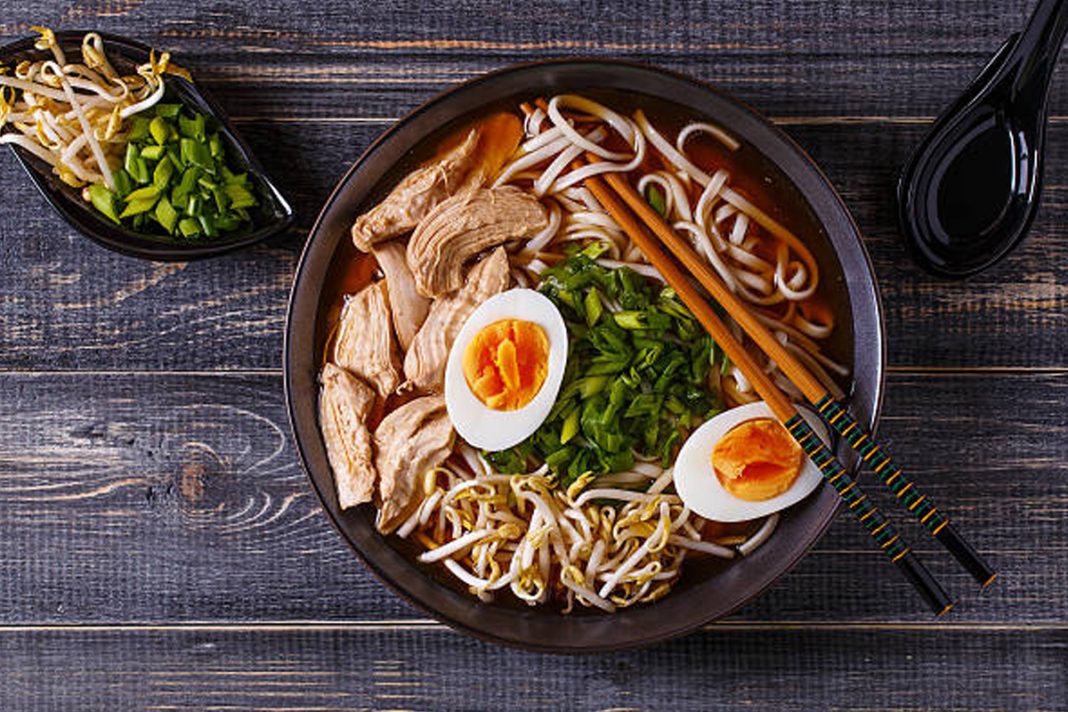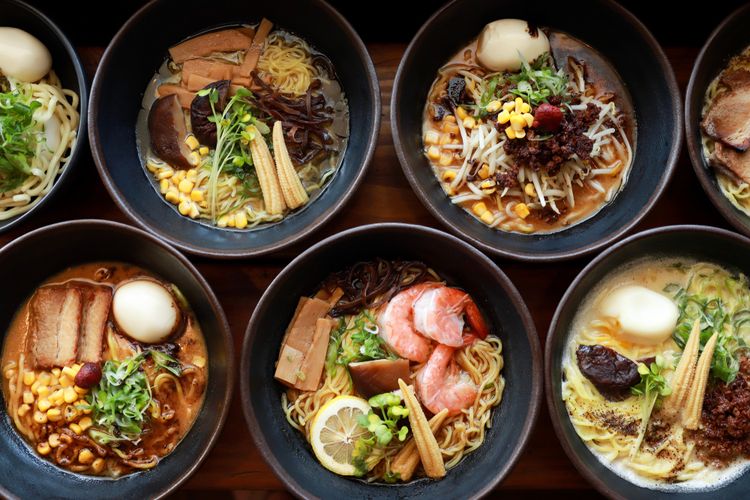Ramen noodles, the iconic Japanese dish, has captured the hearts and taste buds of food enthusiasts worldwide. With its harmonious blend of flavors, textures, and aromas, ramen has become a delicacy that demands attention. In this article, we will delve into the intricacies of ramen, highlighting its cultural significance, diverse styles, and why it has earned its place as a culinary delight.

- Cultural Significance of Ramen:
Ramen holds a special place in Japanese culture, transcending its humble beginnings to become a symbol of comfort and nourishment. It is often enjoyed as a communal meal, bringing people together to share a bowl of warmth and flavor. Ramen shops, known as “ramen-ya,” have become culinary institutions, where chefs pour their expertise and passion into every bowl they serve. - The Art of Ramen-Making:
Crafting a bowl of ramen is an art form that requires skill, patience, and attention to detail. It starts with the noodles, carefully selected and cooked to the perfect texture, whether it’s thin, thick, curly, or straight. The broth, the heart of ramen, undergoes a meticulous process of simmering bones, vegetables, and seasonings for hours, resulting in a complex and flavorful elixir. Toppings such as tender slices of pork, marinated eggs, nori seaweed, and scallions add both visual appeal and complementary tastes. - Exploring Ramen Styles:
Ramen comes in various regional styles, each with its distinct characteristics. Tonkotsu ramen, originating from Fukuoka, features a rich and creamy pork bone broth. Shoyu ramen, prevalent in Tokyo, boasts a soy sauce-based broth that balances savory and umami flavors. Miso ramen, hailing from Sapporo, showcases a fermented soybean-based broth with a robust and slightly sweet profile. Shio ramen, a salt-based broth originating from Yokohama, offers a delicate and light flavor. - Fusion and Creativity:
While traditional ramen styles have their place of honor, the beauty of ramen lies in its ability to adapt and fuse with different culinary influences. Chefs around the world have taken liberties with ramen, incorporating local ingredients and techniques to create innovative variations. From vegetarian ramen to spicy seafood ramen, the possibilities are endless, and the fusion of flavors adds a new dimension to this beloved dish. - The Ramen Experience:
Partaking in a bowl of ramen is more than just a meal; it is an experience that engages all the senses. The steam rising from the bowl, the aromas wafting through the air, the vibrant colors of the ingredients, and the symphony of flavors dancing on your tongue—all contribute to a memorable dining experience. Ramen invites you to slow down, appreciate the craftsmanship behind each component, and relish the moment.
Conclusion:
Ramen’s journey from its humble origins to its status as a global delicacy is a testament to its exquisite flavors and cultural significance. Whether you savor traditional ramen styles or explore innovative variations, each bowl offers a unique gastronomic adventure. So, embrace the delicacy of ramen, seek out authentic ramen-ya, and let this Japanese masterpiece transport you to a world of culinary bliss.

The Delicacy of Ramen: A Gastronomic Journey
Ramen, a Japanese delicacy that has taken the world by storm, is more than just a bowl of noodles. It is a culinary masterpiece that combines flavors, textures, and aromas in a harmonious symphony. In this article, we will delve into the world of ramen, exploring its rich history, diverse styles, and provide insights into how you can recreate this delectable dish in your own kitchen.
- A Brief History of Ramen:
Ramen originated in China and made its way to Japan in the late 19th century. Initially, it was a simple dish consisting of wheat noodles served in a soy-based broth. Over time, various regions in Japan developed their unique styles, such as the rich and creamy tonkotsu ramen from Fukuoka and the soy-based shoyu ramen from Tokyo. Ramen has since become a global sensation, with countless variations and adaptations in different parts of the world. - The Components of Ramen:
Ramen comprises several key components that come together to create its extraordinary flavors. The noodles, made from wheat flour, can vary in thickness and texture. The broth, the heart of any ramen, can be categorized into four main types: tonkotsu (pork bone), shoyu (soy sauce), miso (fermented soybean), and shio (salt-based). Toppings such as chashu (braised pork), ajitama (marinated soft-boiled egg), nori (seaweed), and scallions add depth and visual appeal to the dish. - Cooking Ramen at Home:
While ramen masters spend years honing their skills, you can create a delicious bowl of ramen at home with a few simple steps. Start by selecting the type of ramen you wish to make based on your preferences. Next, prepare the broth by simmering bones, vegetables, and aromatics for several hours. Alternatively, you can use pre-made broth or soup bases available in stores. Cook the noodles according to the package instructions, ensuring they are al dente. Finally, assemble your ramen by placing the noodles in a bowl, adding the broth, and garnishing with your choice of toppings. - Experimenting with Ramen:
One of the beauties of ramen is its versatility, allowing you to experiment with different flavors and ingredients. Consider adding roasted garlic, ginger, or spices like chili oil or sesame seeds to enhance the taste. You can also include vegetables, mushrooms, or seafood to create your unique ramen creation. Don’t be afraid to explore and tailor the dish to your liking, as ramen is a canvas for culinary creativity. - Appreciating the Delicacy:
When you sit down to enjoy a bowl of ramen, take a moment to appreciate the delicate balance of flavors and textures. Observe the aroma, savor the richness of the broth, and relish the chewiness of the noodles. Ramen is not merely a meal; it’s an experience that allows you to immerse yourself in the artistry of food.
Conclusion:
Ramen has transcended borders and become an international sensation for a reason. Its complex flavors, attention to detail, and endless possibilities make it a delicacy worth exploring. Whether you’re slurping a bowl at a local ramen shop or trying your hand at recreating it at home, ramen promises to take your taste buds on a journey you won’t soon forget.

Mastering the Art of Cooking Ramen: A Step-by-Step Guide
Cooking ramen from scratch can be a rewarding experience that allows you to create a personalized bowl of this beloved Japanese delicacy. In this article, we will guide you through the process of cooking ramen, from preparing the broth to selecting the perfect toppings, ensuring that your homemade ramen is a culinary triumph.
- Choosing the Type of Ramen:
The first step in cooking ramen is deciding on the style you want to create. Consider the flavor profile you desire—whether it’s a rich and creamy tonkotsu, a savory shoyu, a robust miso, or a delicate shio. Each style has its unique characteristics, so select the one that best suits your preferences. - Preparing the Broth:
The broth is the soul of ramen, providing depth and richness to the dish. While making traditional broth can be time-consuming, there are shortcuts available. For a tonkotsu-style broth, simmer pork bones and aromatics like garlic, ginger, and onions for several hours until the liquid becomes creamy and flavorful. For a quicker option, you can find pre-made broth or soup bases at your local Asian grocery store. - Cooking the Noodles:
The noodles are an essential component of ramen, and getting them just right is crucial. Start by selecting the type of noodles you prefer—thin or thick, straight or wavy. Cook the noodles according to the package instructions, but be careful not to overcook them. Ramen noodles should be cooked al dente, with a slight chewiness to them. Rinse them with cold water to stop the cooking process and remove excess starch. - Adding Toppings:
Toppings add visual appeal and additional flavors to your ramen. Traditional toppings include chashu (sliced braised pork belly), ajitama (marinated soft-boiled egg), nori (seaweed), menma (bamboo shoots), and scallions. However, you can let your creativity shine by incorporating other ingredients such as bean sprouts, corn, mushrooms, or even slices of grilled chicken or beef. Arrange the toppings artfully on top of your noodles and broth. - Serving and Enjoying:
Once your ramen is assembled, it’s time to serve and enjoy your creation. Use a pair of chopsticks and a spoon to eat your ramen. Slurping the noodles is encouraged in Japanese culture as it helps to cool the hot noodles and enhances the flavors. Take your time to savor the different elements, letting the flavors dance on your palate.
Conclusion:
Cooking ramen is a delightful culinary adventure that allows you to unleash your creativity in the kitchen. By following the steps outlined in this guide, you can create a bowl of ramen that rivals those served in renowned Ramen noodles shops. So, don your apron, gather the ingredients, and embark on the journey of mastering the art of cooking ramen in the comfort of your own kitchen.